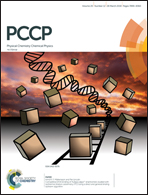Competitive DNA binding of Ru(bpy)2dppz2+ enantiomers studied with isothermal titration calorimetry (ITC) using a direct and general binding isotherm algorithm†
Abstract
While isothermal titration calorimetry (ITC) is widely used and sometimes referred to as the “gold standard” for quantitative measurements of biomolecular interactions, its usage has so far been limited to the analysis of the binding to isolated, non-cooperative binding sites. Studies on more complicated systems, where the binding sites interact, causing either cooperativity or anti-cooperativity between neighboring bound ligands, are rare, probably due to the complexity of the methods currently available. Here we have developed a simple algorithm not limited by the complexity of a binding system, meaning that it can be implemented by anyone, from analyzing systems of simple, isolated binding sites to complicated interactive multiple-site systems. We demonstrate here that even complicated competitive binding calorimetric isotherms can be properly analyzed, provided that ligand–ligand interactions are taken into account. As a practical example, the competitive binding interactions between the two enantiomers of Ru(bpy)2dppz2+ (Ru-bpy) and poly(dAdT)2 (AT-DNA) are analyzed using our new algorithm, which provided an excellent global fit for the ITC experimental data.



 Please wait while we load your content...
Please wait while we load your content...